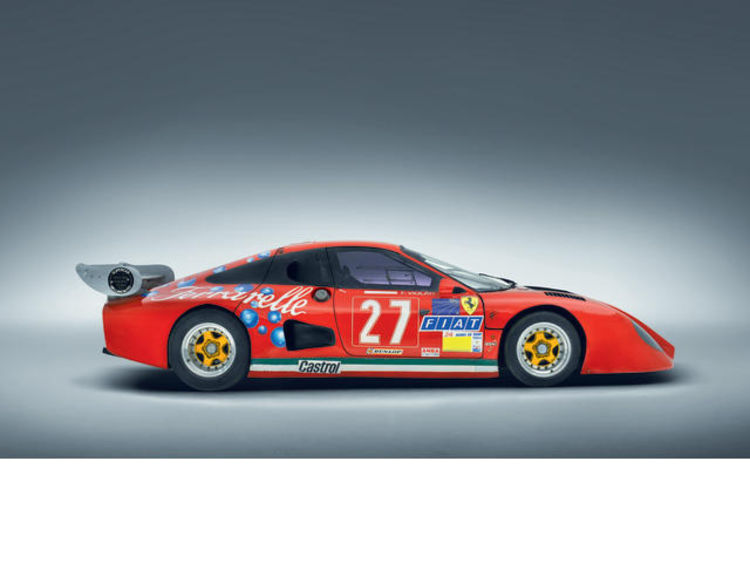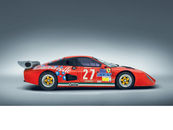1981 FERRARI 512 BOXER BERLINETTA BELLANCAUTO LE MANS ENDURANCE RACING COMPETITION COUPE
Description: |
|
| SOLD SOLD SOLD for US$ 990,000 (£593,422) including buyers premium. The Ex-Fabrizio Violati, Maurizio Flammini, Duilio Truffo, Marco Micangeli 1981 and 1984 Le Mans 24-Hours race 1981 FERRARI 512 BOXER BERLINETTA BELLANCAUTO LE MANS ENDURANCE RACING COMPETITION COUPE Chassis no. 35529 Engine no. F102B-009 *Uniquely sophisticated 5-litre flat-12 engined aerodyne *Veteran of not just one Le Mans 24-Hours race – but two *Also competed at World Championship level at Monza and Mugello *Offered after 23 years in the Collezione Maranello Rosso *A highly individualized 200mph Boxer Berlinetta/Le Mans THE FERRARI 512 BOXER BERLINETTA Ferrari as a marque has always been understandably protective of its towering prestige. When the rival Maserati and upstart Lamborghini factories put sophisticated rear-engined performance cars into production - while Ferrari was still marketing its front-engined 365GTB/4 Daytona series - the Maranello model range began to look traditional and dated. The new, probably younger generation of 'supercar' enthusiasts voted with their feet, and such models as the Lamborghini Miura and the Maserati Bora began to steal Ferrari sales. Against this background Ferrari developed its own rear-engined exotic, the 365 Boxer Berlinetta with 4.4-litre flat-12 cylinder engine mounted behind the cabin. This startling break from tradition was launched in 1973. The early cars were well received, being lighter, more nimble and more responsive than the big front-engined Daytona. The rear-engined Berlinetta concept was further developed in 1976 with release of the full 5-litre flat-12 engined 512 BB. Although the increase in outright horsepower was modest, from 344bhp at 7,000rpm to 340bhp at 6,800, the improvement in mid-range torque was considerable. By mid-1981 the 512 BB had been fitted with Bosch engineered K-Jetronic fuel injection, and renamed the 512 BBi. Inevitably, some enthusiastic Ferraristi wanted to race suitably modified and race-prepared versions of the Boxer Berlinetta cars in such frontline events as the Daytona and Le Mans 24-Hours and the Sebring 12-Hours. By 1978 four circuit-racing 512 BBs ran at Le Mans, another competed in the Watkins Glen 6-Hours but little tangible success resulted. Then in 1979 genuine interest was shown in developing the latest Boxer Berlinetta 512s for serious endurance racing. The factory's Assistenza Clienti Department in Modena laid down a production run of 25 512BB/LM 'customer racers', with bodywork developed in Pininfarina's wind tunnel at Grugliasco. A rear wing derived from that used on the Formula 1 312T-series cars was adopted, and this considerable volume of aerodynamic work not only increased the cars' maximum speed but also improved its grip and traction. Most engine parts were from stock, but the power units were carefully 'blue-printed' and painstakingly assembled. Fuel injection was uprated together with a carefully flowed exhaust system. Lightweight engine internals were carefully balanced and both valves and ports were enlarged, and higher-lift camshafts adopted. Power output rose to a quoted 480bhp. The cars were 16-inches longer than stock, and these latest 512BB/LM-79 cars rode on 10-inch wide front wheels and 13-inch wide rears. Weight was cited as 1,080kg. On Fiat's Nardo test track an early prototype was said to have exceeded 207mph. But by 1983 there would not be a single Ferrari entry at Le Mans, the first time since the great race's postwar revival in 1949. Fabrizio Violati was one leading Ferrarista who would not rest until that situation had been corrected... THE MOTORCAR OFFERED This Boxer Berlinetta Le Mans was assembled initially as a rolling chassis under the supervision of Gaetano Florini at Ferrari's customer Assistenza Clienti division in Modena. It is one of the so-called third series of 16 512 BB/LM competition Berlinettas – several of which would never be raced but would instead sell direct into Ferrari collections around the world. Chassis '25229' now offered here, however, was very much a real race car, and in April, 1981, it was delivered brand-new to Fabrizio Violati's Scuderia Bellancauto workshops in Rome. Specialist engineer Armando Palanca, assisted by Roberto Lippi and the Ferrari factory's renowned veteran chief mechanic Giulio Borsari, then embarked upon an intensive programme of development and individual modification to create the definitive Ferrari BBB512 – Berlinetta Boxer Bellancauto – now offered here. This much-modified car then made its racing debut in the hands of Fabrizio Violati himself, Maurizio Flammini and Spartaco Dini in the Monza 1,000Kms classic on April 26, 1981. Running under race number '15' the trio promptly won their class while finishing a fine sixth overall amongst the sports-prototype cars – engineer Palanca's modifications plainly having provided a very fast and driveable race car. Fabrizio Violati then ran the car in its first Le Mans 24-Hour race, sharing it on the Sarthe Circuit with co-drivers Maurizio Flammini and Duilio Truffo. The car bore race number '45' but sadly had to be withdrawn from the day-long grind due to transmission trouble. Just two weeks later, on June 28, 1981, '35529' offered here was out in battle yet again, contesting the Enna 6-Hours around Lake Pergusa on the island of Sicily. Fabrizio Violati and Duilio Truffo co-drive it, and again finished sixth overall. On September 10, 1982 – the car reappeared in the Mugello 1,000Kms for the Trofeo Banco Toscana, in which Fabrizio Violati and Duilio Truffo finished tenth overall. During 1983 Fabrizio Violati then kept the car in reserve, until in the Spring of 1984 it was out again testing at Vallelunga under his Scuderia Bellancauto banner, then wearing Michelin tyres in place of its original Dunlops. On May 6, 1984, Maurizio Micangeli, Marco Micangeli and 'Gero' (Cristiano del Balzo) shared the car in the Imola 1,000Kms – running under race number '27' However, engine failure halted their race after 91 laps – long enough for such a failure to hit hard as an extreme disappointment. The Violati-run Scuderia Bellancauto's second Le Mans 24-Hour race outing with this ever-developing and extremely fast Boxer Berlinetta Bellancauto then followed on June 16. It was driven by Marco Micangeli, Roberto Marazzi and Dominique Lacaud – again numbered '27' – in the IMSA GTX class. It was then sidelined after six hours racing due to gearbox trouble. On June 22, 1985, Fabrizio Violati ran the car spectacularly during the Ferrari Club Italia meeting in Alessandria, Italy, and it was subsequently inducted into the Collezione Maranello Rosso museum on extended display. Fabrizio Violati passed away on January 21, 2010 – aged 75 – and the car is now offered here fresh from the Collezione's most recent home – his tailor-made Museum at Falcione, near Rimini, Italy. As offered here this unique Boxer Berlinetta Bellancauto is very much a retired old warhorse that has been preserved on display within its owner's Museum for the past thirty-plus years. As such it is not only in highly original condition but for connoisseurial admirers of patina it certainly offers more than one could ever require. Just consider its longitudinal aerodynamic sill panels, hung between front and rear wheel arches. They are waved and scarred as enduring evidence of '35529's hard-charging Italian racing drivers having energetically saved split seconds on-circuit by slamming over the chicane kerbs at Le Mans, Monza, Mugello and Imola. The car's cabin roof displays the hastily-opened cooling louvres sliced into its aluminium skin by under-pressure Italian racing mechanics working in hot blood. A patch panel on the car's scuttle has been equally hastily brush-painted rather than sprayed – all evidence of the hard-pressed realities of racing over thirty years ago. While nothing was compromised by considerations of concours-style finish in real hard-bitten race cars such as this, there is no doubting the technological sophistication of Bellancauto's famous Boxer Berlinetta. The long, downswept nose and tail panels streamline an awe-inspiring mechanical assembly. Pop the pip-pins from the rear clamshell body section's hinges and lift the panel clear of the car and its massive 5-litre fuel-injected flat-12 cylinder engine/transmission aggregate is revealed for all to admire. At first acquaintance it is literally a jaw-dropping sight. Tug open the car's ultra-lightweight doors and its black-trimmed, black-painted cabin shows every evidence of its long, hard and uncompromising career as a weapon of competitive endeavour. Settle into its body-wrapping, shoulder-supporting driver's seat, and study the simple dash panel beyond the small-diameter, thickly-padded steering wheel ahead. Close to your right hand stands the tall manual gearshift, beside a sloping multiple-switch panel to command lights, electrics, your immediate racing future. The entire cabin is protected by a large-diameter tube roll-over cage, the BBB/LM's pledge of personal security, and the car is piped with an onboard fire extinguishing system. Gaze forward through its glued-in, tag-retained multi-curvature windshield and the nose ducks away out of sight. Imagine how '35529's gentleman and warrior drivers would have seen the classical race circuits of Le Mans and Monza streaming back towards them through this broad windshield as they floored the throttle and that immense power pack behind their shoulders fired them like a cannonball towards the horizon. Hammering on above 180mph, then 190, this sleek Ferrari would have exercised its purebred lineage along the Mulsanne Straight, reaching to 200mph before the famous Mulsanne Kink, or past the Monza pits towards the Curva Grande complex. Its black-finished cabin – matted to avoid dazzling reflections from bright Mugello sun or dazzling after-midnight Le Mans headlights – reminds one more of an heroic age jet fighter cockpit than of a real, muscle-bound race car, but this was the typical office for a working race driver of the 1980s. As offered here today this is a highly original racing Ferrari – veteran of not just one Le Mans 24-Hour race, but of two – and it is one which offers a well-tuned new owner/driver the prospect of many highly enjoyable and satisfying miles of extremely high-performance Vintage racing. The car would be entirely acceptable for the highly-regarded Le Mans Classic event in France, and as such a unique veteran of the FIA World Championship racing scene it could provide a ticket to many more of the world's highest-profile Vintage, Historic and classic car events – up to and including the illustrious Goodwood Festival of Speed in England. We commend it to the market, and recommend the closest and most thoughtful inspection. Once mechanically restored and properly race-prepared this promises in good hands to be a potential Vintage race winner of tremendous presence and distinction. |
|
Members profile: |
|
| Advertised by: | Bonhams Motor Cars USA (click here to see full profile) |
| Email: | Email Advertiser |
Ad Details |
|
| Garage Spaces (put 0 if this does not apply) | 0.00 |
| Property is | Sold |
| Price: | $990,000 USD |
| Make: | Ferrari |
| Model: | 512 Boxer Berlinetta Bellancauto Le Mans Endurance Racing Competition Coupe |
| Year: | 1981 |
| New or Used: | Used |
| Type: | Car, Classic Vehicle / Collector Vehicle, Exotic Vehicle |
| Price Info | Sold at auction for US$ 990,000 (£593,422) including buyers premium. |
| Exterior Color: | Red |
For Sale at Auction |
|
| Auction Sale? | Yes |
| Type of Auction | No Reserve Price |
| Auction Date | 08/14/2014 |
| Auction Time | 5:00PM PDT |
| Location | Quail Lodge in Carmel California |
| Name of Auction | Bonhams Quail Lodge Auction |
Unique Sale Issues |
|
| Type of Sale | Auction Company Sale |
Location |
|
| View on map | |
| Address | 8000 Greens Valley Dr. |
| City | Carmel |
| State | CA |
| Postal Code | 93923 |
| Country | USA |
Call Me! |
|
| Phone | +1 415 391 4000 |
| Ad id: | 17353000 |
| Views: | 4908 |


